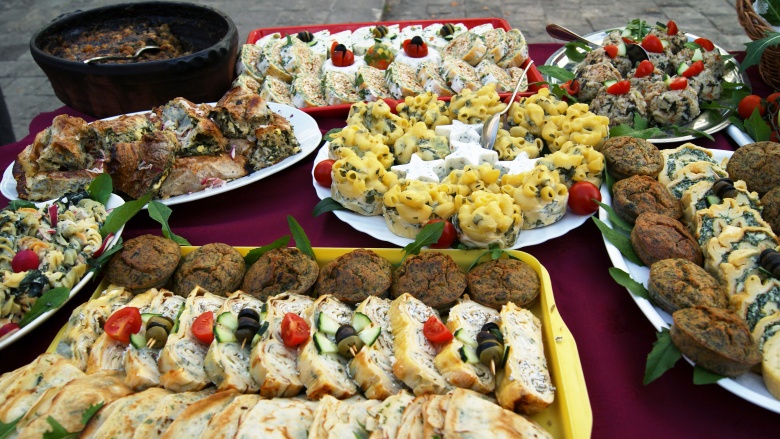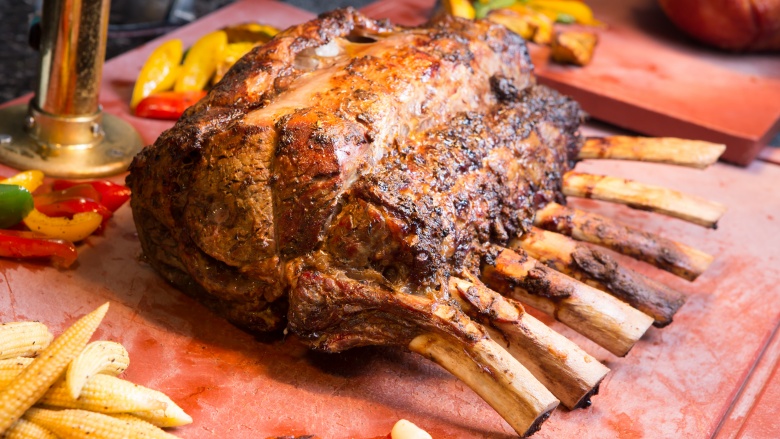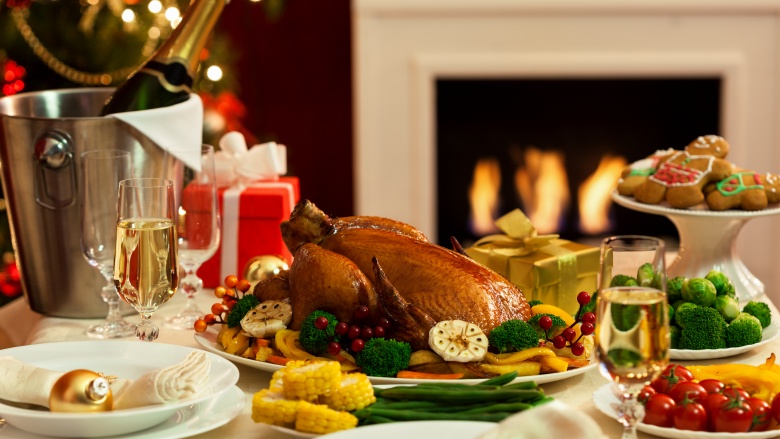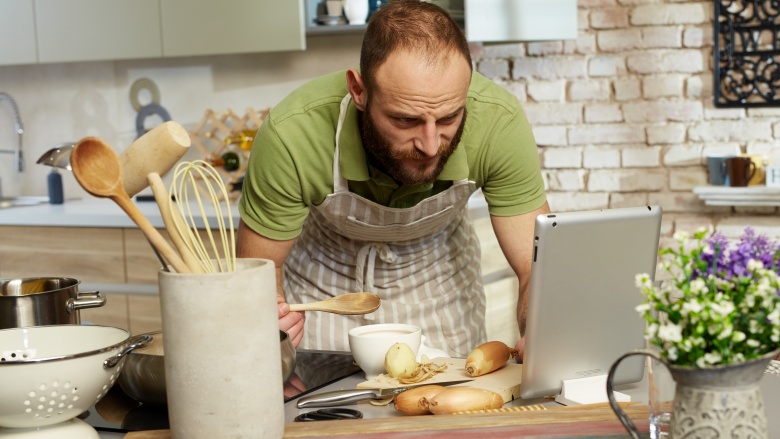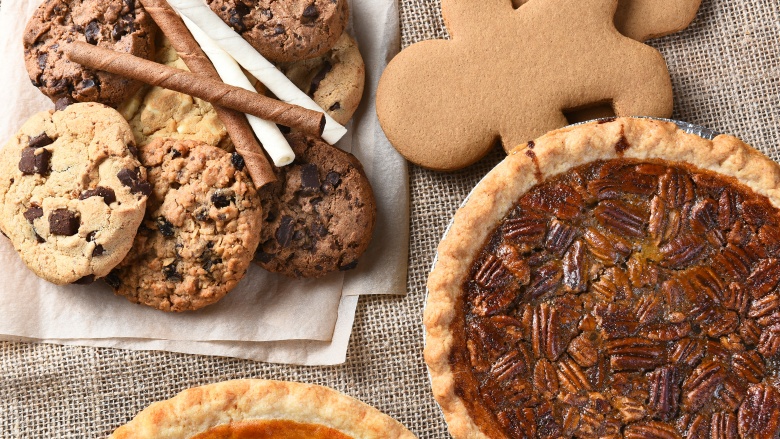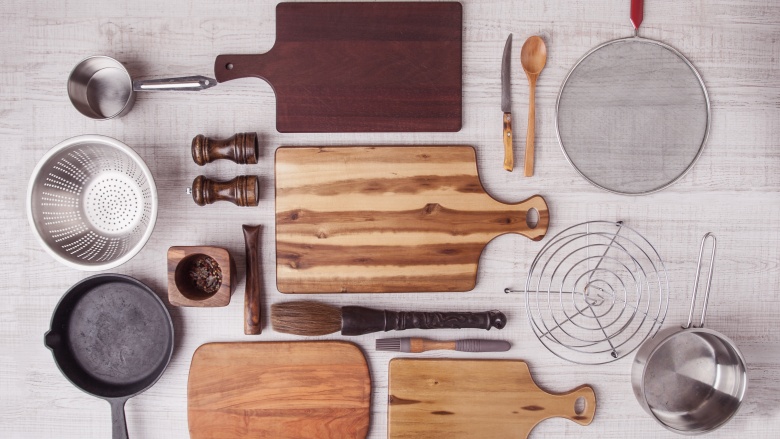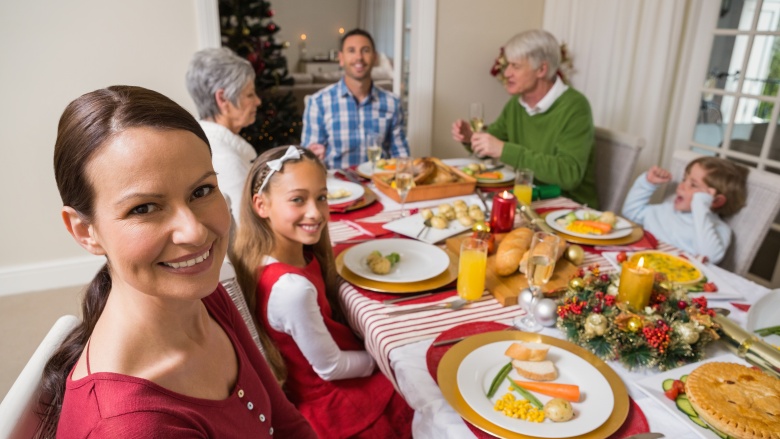How To Cook The Perfect Holiday Meal
So, you wanna host a holiday meal? Well, you came to the right place. I have hosted holidays in tiny NYC apartments and sprawling suburban homes ... everything from Easter brunches to New Year's Eve soirees to Halloween parties to traditional Christmas dinners, plus more Thanksgivings than I could even count. Heck, I hosted a Rosh Hashana once, and I'm not even Jewish. Along the way, guests at my holiday table have included friends, family, random neighbors, and co-workers, and I've learned valuable lessons from each and every event: what to do and what not do to ensure a successful and nearly stress-free holiday. So take my hand and let me guide you in how to cook the perfect holiday meal.
What should you make?
Deciding what to make for your holiday feast can be the most stressful and most fun part of the voyage you're embarking on. When poring over holiday recipe magazines and your fave foodie websites, keep a couple of rules of thumb in mind.
First, be realistic in your abilities, and your time frame. This isn't the day to try some new, advanced cooking technique you just saw on Top Chef. Pick recipes similar to those you have successfully pulled off in the past or ones that have few steps.
Second, plan on making recipes where a bulk of the work can be done long before your guests arrive. Bonus points for recipes that can be completely assembled the day before and reheated in time for dinner.
Third, consider the limitations of your cooking space. If you have double ovens, you can go casserole crazy, but if you're working with a tiny, apartment-style oven, recipes that are prepared on the stovetop or served chilled or at room temperature are your best buds. I once cooked a huge Thanksgiving dinner for 12 in my Brooklyn apartment kitchen utilizing my crockpot, stovetop, and toaster oven. It's possible!
Fourth, think about your guests. Any vegetarians? Shunners of gluten? Food allergies? No, you don't need to cater the entire meal to one person's preferences, but knowing that there are a couple of items that each person can enjoy is a classy move by a host. I once cooked Ina Garten's lobster mac and cheese for a New Year's Eve dinner, only to find out that one of my guests didn't eat lobster. A little homework on my part would have avoided that dilemma.
Fifth, if you are making a show-stopping meal, take it easy on appetizers. Limit yourself to two or three hors d'oeuvres. I usually make one dip with crudite and crackers, one hot item to pass, and something easy to grab like spiced nuts or cheese straws. Make sure to have at least one item ready as soon as guests walk in the door, particularly if they traveled far to reach you.
Last but not least, try to serve a balanced meal. Proteins are filling, so take that into account when planning appetizers and side dishes. Do a lot of your sides include cream or cheese? Are all your veggies on the starchy side? Offset heavier dishes with a simple sauteed green vegetable or salad.
How much food do you need per person?
I know, I know. You're very concerned that you won't have enough food, right? And it's a legitimate worry. Major holiday meals are ones where we typically indulge to our heart's content, and you wouldn't want to be the host who didn't allow everyone to gorge on mashed potatoes. While I have prepared holiday meals for groups from 4 to 24, one lesson that I have learned is that you actually don't need quite as much as you may think you do. It all depends on how many separate items you plan on making and how far apart you plan to space out your courses. For appetizers, you can count on each person eating three or four bites of a dip, and another three or four bites of a hot hors d'oeuvres. Remember, you don't want to fill everyone up before they even get to the main meal that you've slaved over.
If you're making up to three side dishes, follow the recipe directions to estimate portions per person. Once you get beyond three dishes, you can pare that number down a bit. For example, if a recipe says it will serve six, you can still comfortably serve it to 10 people and have leftovers. The same is true of holiday pies and cakes. The more separate items you serve, the less of each item you actually need. Most people will want a small slice of each dessert anyway.
How big of a bird or roast do you need?
This is another stressful decision, but it doesn't need to be. This handy chart will tell you exactly how much meat you should plan to serve. If the amounts surprise you, keep in mind, meat loses weight when cooked, and those bones take up lots of space. (And they impart tons of flavor!)
For turkey (or other birds like duck or goose), the popular wisdom says that 1-1½ pounds per person is about right. If you know you have a group that fights over the prized white meat, you can always prepare a separate turkey breast to keep everyone happy and civilized.
For ham, bone-in ham will require about ¾ pound per person, and with a boneless ham you will need about ½ pound per person.
For prime rib (sometimes called a standing rib roast), serve about 1 pound per person. A four-bone roast is the right amount of meat for 8-10 people.
For rack of lamb, an average, 8-chop rack of New Zealand or Australian lamb is generally enough for two people. American lamb is larger, so count on 2 chops per person.
For pork roast (sometimes called a standing or crown roast), serve 1-2 chops per person.
For beef tenderloin, serve ⅓-½ pound per person.
Buffet, plated, or family-style?
The answer to the question of how to serve your meal lies in how many guests you're cooking for. If you envision the quintessential dinner party with guests being served elegantly pre-plated meals and you're cooking for a small group, knock yourself out.
Family-style meals, those iconic holiday scenes with all the food presented and passed at the table, can be lovely, assuming you have a sizable table. If you do choose this method, I recommend presenting your turkey or roast at the table so you can hear all your well-deserved cries of appreciation, and then swiftly retreating to the kitchen to carve it. You don't want to elbow any guests in the face, and you certainly don't want juices running all over your favorite tablecloth. Be sure to keep side dishes well covered until the meat is carved so they don't get cold while your guests are waiting. I would only choose this option if you know you are skilled at carving your turkey or roast in a timely manner or if you have wisely employed a more experienced guest to do it for you.
My favorite way to serve any holiday crowd is buffet-style. Guests are free to heap their plates with whatever they like in whatever amounts they like. A sturdy card table or kitchen counter makes a great buffet. If serving gravy, bread, or salad, I keep those items on the dining table, along with butter and salt and pepper, and I make sure to set these on each table if I have multiple tables for a large group. If you have chafing dishes, they can be used to keep your food warm while it's served, or you can simply cover items with aluminum foil to keep everything at the perfect temperature for seconds and thirds.
How to create a cooking timeline
If you take just one piece of advice I give you, let this be the one. Creating a written cooking timeline will quite simply be the kindest thing you can do for yourself when planning any kind of dinner party. For a big party or major holiday, my timeline can start up to a week ahead. It includes grocery lists, my full menu, and prep work that I plan to do before the big day. For the day of the party itself, I list tasks by the hour and keep it taped to my fridge for easy reference. Here's an edited example of my Turkey Day timeline from last year:
- Monday: Pick up turkey and other groceries. Dry brine the turkey and store in brining bag in downstairs fridge.
- Tuesday: Flip turkey over. Prepare herb butter for turkey. Make cranberry sauce. Buy wines.
- Wednesday: Remove turkey from brining bag, stuff skin with herb butter, stuff cavity with herbs and oranges, and set in roasting pan in fridge to air dry. Prepare stuffing. Prepare swiss chard gratin. Peel and soak potatoes. Set table.
- Thursday, 10 a.m.: Remove turkey from fridge. Make mashed potatoes and transfer to crockpot.
- 11 a.m.: Preheat oven to 425°.
- 11:30 a.m.: Turkey in oven. Set up bar area. Prepare salad without dressing.
- 12:00 p.m.: Guests arrive. Set out cold apps. Turn oven temp down to 375°.
- 1:00 p.m.: Present hot apps. Remove side dishes and butter from fridge to bring to room temp.
- 2:00 p.m.: Check turkey, remove from oven and tent.
- 3:00 p.m.: Side dishes in oven. Make gravy.
- 3:45 p.m.: Side dishes out of oven. Heat bread/rolls. Carve turkey. Toss salad.
- 4:00 p.m.: Dinner
- 5:00 p.m.: Heat pies. Take ice cream from freezer. Make coffee. Cream/sugar on table.
- 5:30 p.m.: Dessert
It's that easy. And when you're standing in the kitchen, juggling casserole dishes and a glass of prosecco while Aunt Ethel is trying to talk to you about Uncle Frank's shingles, you'll be happy you have that organized timeline to remind you what to do next. You're welcome!
What can be made ahead?
Prepping and assembling the bulk of your food before your guests arrive (and Ideally before the big day itself) is an absolute must when preparing a holiday meal for a large group. Casseroles are ideal for make-ahead side dishes. Simply assemble them a day or two before your big day, bring them to room temperature (about 45 to 60 minutes out of the fridge should do the trick), and cook according to the recipe directions. Have multiple sides dishes that require different temperatures? Don't fret. Calculate the average temperature of your different recipes, pop everything into the oven, and then just check for doneness. Remember, recipes that you may have doubled or tripled will require longer cooking times. Give carb-heavy casseroles like lasagna and mac and cheese a chance to set before you serve them.
Salads can be prepped earlier in the day before your party begins, but don't dress the salad until about 15 minutes before you plan to serve it. If you want to serve a sauteed vegetable, you can cook and blanch it the day before to speed up the cooking time. Breads, cakes, and pies are perfect for make-ahead items, as are dips. Roasted root vegetables can be roasted a day before and reheated the day of. Many sauces and reductions can be made ahead.
Mashed potatoes can be made earlier in the day and kept warm in a crockpot. Pro tip: stir some extra cream and butter into them every hour or so before you're ready to serve. The potatoes themselves can be peeled and cut the day before if you store them in the fridge in a pot filled with cold water to prevent browning. If that won't work, you can always serve a make-ahead mashed potato casserole.
What should guests bring?
Personally, I don't like to relinquish too much control of what is served at the actual meal, so I generally ask my guests to bring dessert and wine. It's smart to keep track of who is bringing what, lest you end up with four apple pies and a lone bottle of asti spumante. It's OK to be specific about what you're asking people to bring. Those who aren't whizzes in the kitchen will prefer it. If someone has easier access to a special pie or bread you'd like to serve, ask them to go fetch it. If your aunt makes the most amazing stuffed artichokes (like mine does), ask her to bring them. If you're comfortable with more of a potluck-style gathering, go ahead and tell people to bring side dishes or appetizers. And by all means, ask someone to bring ice.
Make sure you've dusted off your vases in case anyone brings cut flowers. If someone shows up with an unrequested sweet potato casserole, accept it graciously and serve it alongside your meal. Some people may bring you a hosting gift, like a bottle of olive oil or balsamic vinegar. Those people are awesome.
How should you assign tasks to guests?
People like to feel helpful, so if a guest asks what they can do, take advantage and assign them a task. I usually select one helpful guest who knows what they're doing in the kitchen to assist me with things like chopping herbs, retrieving items from the oven, and so on. If anyone else offers to help, I get them involved in ways that don't intrude on my cooking space. I have asked guests to pass hors d'oeuvres, collect dirty plates and glassware from around the house, take people's coats to a bedroom, fill water glasses, open bottles of wine, light candles, you name it. As long as it keeps my cooking area clear and keeps me focused on my timeline, I'll take it. If you have someone who knows how to carve a bird or a roast, let them do it for you. If the task falls on you and you're a newbie, YouTube is your new carving instructor.
What equipment will you need?
There is no need to go out and buy hundreds of dollars worth of special dishes and equipment just because you're preparing a holiday meal. Sure, I now own enough matching serving platters, casserole dishes, and serving cutlery to entertain an army, but I have assembled that arsenal over years. Yard sales are a great way to get your hands on serving dishes, as are thrift stores. My local supermarket always has great deals on Pyrex dishes during the holiday season. Go ahead and borrow what you need from friends and neighbors. As you become the house that your friends and family consider the gathering place, the gifts you eventually receive will start to reflect that. If you're really on a budget, there's no shame in using grocery store disposable cookware, although you may want to double layer when making heavy items like turkeys or casseroles.
Which beverages should you serve?
In my first attempts to host holidays at my home, I went a little bit overboard trying to please every whim when setting up my bar and offered my guests a myriad of mixers, garnishes, and booze. I realized quickly that it just wasn't necessary. I now set out white and red wine, beer, water, flavored seltzer, and juice for the kids. If a guest wants hard alcohol, I direct them to where it's stored. If you know they enjoy one particular drink, suggest that they bring it beforehand. A few cans of diet soda and ginger ale on hand are smart, but as long as you offer guests both alcohol and soft drinks, they'll happily make do with what you offer. A punch or a signature holiday cocktail is a fun way to offer guests something special without cluttering your bar area with too many choices. If you have the space, set your bar up away from the dining area and your cooking area, and keep a dish cloth there to quickly mop up accidental spills.
Some helpful hints
Good news! You definitely don't need to make every single dish from scratch. Be kind to yourself and cook the things that you're good at and enjoy making, then buy the rest at the store. I buy my Thanksgiving gravy every year because the stress of trying to make it was too much. Ditto for whipped cream.
There's no need to be overly fussy. I have learned over the years that people adore those Pillsbury crescent rolls, and that many folks prefer canned cranberry sauce to freshly made. Despite my persistence in making fancier appetizers, guests always go gaga for pigs-in-a-blanket and Lipton onion soup dip with potato chips.
Gravies and sauces stay beautifully hot in a caterer-style coffee carafe.
If a recipe that you plan on making is freaking you out, find an easier version or give your recipe a test run. Take notes about what works and doesn't in the recipes you try so you know for next time.
Get your knives sharpened before you begin. If you don't own any good knives, consider treating yourself to one.
Cook food that you yourself would want to eat. My father-in-law insists he hates mushrooms, but he sure can put away a huge helping of my truffled mashed potatoes.
Buy cheap plastic containers ahead of time so guests can take home leftovers. Better yet, tell them to bring their own containers.
Lastly, have fun. Enjoy your guests, enjoy your holiday, and remember: if you screw something up, there's always next year.


